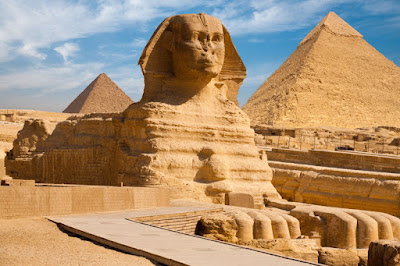The Sphinx of Giza
 |
| (Sphinx of Giza) |
Some of the layers of rock the Sphinx was carved out of were harder or softer than others which led to uneven erosion. The interesting thing about the erosion of the Sphinx is that its believed to be from running water. Several research studies have been done on this and its fairly conclusive. Which leads to the fact that when the Sphinx was built there was substantially more precipitation and perhaps even a much different climate then present day Egypt has. Its is estimated based off of fossils of plant life and artifacts that the area could have hosted vegetation around the year 8,000 BC.
 |
| (The Sphinx during its excavation in the early 1900s) |
The origin and purpose of the Sphinx has left people wondering for centuries. No ancient Egyptian scriptures ever mention the building or the purpose of the Sphinx. While at times it is mentioned but only as something that has existed already, leaving many wondering about its construction. There are no known tunnels or passage ways underneath or inside the Sphinx ruling out its use as a tomb. Over time the Sphinx was eventually buried up to its neck in sand. Not until the early 1900s was it fully excavated. Restoration attempts have been being made to the Sphinx for thousands of years as they still are today, but time continues to take its tole on the monument as it is subject to harsh winds and humidity causing it to further erode.
Works Cited
Gray, By SubjectSacred Sites NewsletterMartin. "The Great Sphinx Facts." Sacred Sites. N.p., n.d. Web. 16 Oct. 2016
@ahencyclopedia. "The Great Sphinx of Giza." Ancient History Encyclopedia. Ancient History Encyclopedia, 26 Oct. 2016. Web. 15 Oct. 2016.
Martin, Parr. "EGYPT. 1992. EGYPT. Giza. The Sphinx. 1992." (1992): ARTstor Digital Library. Web. 15 Oct. 2016.
No comments:
Post a Comment